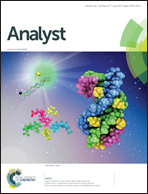Surface plasmon resonance-based immunoassay for human C-reactive protein†
Abstract
A rapid and highly-sensitive surface plasmon resonance (SPR)-based immunoassay (IA) has been developed and validated for detecting human C-reactive protein (CRP), a specific biomarker for inflammatory and metabolic disorders, and infections. The 1-ethyl-3-(3-dimethylaminopropyl)-carbodiimide hydrochloride (EDC)-activated protein A/G (Pr A/G) was diluted in 1% (v/v) 3-aminopropyltriethoxysilane (APTES), dispensed on a KOH-treated gold (Au)-coated SPR chip, and incubated for 30 min. The Pr A/G functionalized Au SPR chip was then bound to anti-human CRP capture antibody (Ab), blocked with bovine serum albumin, and subsequently used for the detection of CRP. The highly-simplified oriented Ab immobilization strategy enabled the leach-proof binding of capture Ab in 5-fold shorter time than conventional procedures. The developed IA detected 1.2–80 ng mL−1 of CRP with a limit of detection (LOD) and a limit of quantification (LOQ) of 1.2 ng mL−1 and 4.6 ng mL−1, respectively. It detected CRP spiked in diluted human whole blood, serum and plasma as well as the CRP levels in the ethylenediaminetetraacetic acid (EDTA) plasma samples of patients with the same precision as the clinically-accredited analyzer-based IA and conventional CRP sandwich ELISA. The Ab-bound SPR chips stored at 4 °C retained their functional activity for 10 weeks, resulting in significant reduction in the overall analysis time.


 Please wait while we load your content...
Please wait while we load your content...